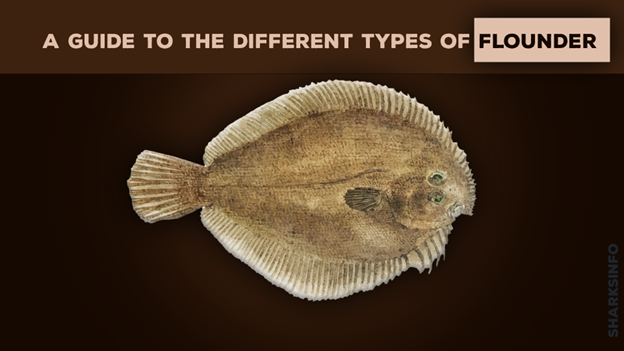While flounders come in many shapes and sizes, they all have some features in common. They are all flatfish, meaning they have flattened bodies with eyes on one side of their head. This gives them the ability to camouflage themselves on the ocean floor. Flounders are also known for their delicious taste and delicate texture.
To be found in a variety of habitats, this guide will help you identify the different types of flounder and learn about their ecology and life history.
What are the different types of flounder?
It is a group of flatfish characterized by its distinctive shape that can be found on ocean bottoms globally, whereas some species may be found in estuaries. The subsequent unit deliberates some of the flounder species that are of importance to fisheries.
1: Gulf flounder
Scientific name: Paralichthys albigutta
Conservation status: Least Concern
Lifespan: 7-10 years
Gulf flounders are a species of flounder found in the Gulf of Mexico. Gulf flounder are bottom-dwelling fish and prefer to live in sandy or muddy habitats. They are ambush hunters and use their disguises to their benefit when pursuing targets. They are a common seafood option and are often taken to be a treat.

2: Southern flounder
Scientific name: Paralichthys lethostigma
Conservation status: Near Threatened
Lifespan: 5 years (Male), 7-8 years (Female)
Southern flounder are a class of flatfish developing in estuarine waters beside the southeastern seaside of the US. They are the prevalent target for frivolous anglers and are also commercially picked. Southern flounder are relatively large flatfish, growing up to (12-14 inches) in length.

They have brown or olive-colored bodies with dark spots, and their right eye is located near the center of their body, while their left eye is located near the tail. They are devious feeders and will eat a range of small fish, crustaceans, and other invertebrates.
3: Summer flounder
Scientific name: Paralichthys dentatus
Conservation status: Least Concern
Lifespan: Up to 20 years
Summer flounder is a fish that is originate in the Atlantic Ocean. The fish are also commonly known as fluke. They are a popular target for recreational saltwater anglers in the Mid-Atlantic constituency. Also, the fish are known for their delicious flesh and are often caught using a variety of methods, including trolling, jigging, and bottom fishing.

As well as being able to color-match their dark sides to the surrounding bottom, summer flounders can burrow rapidly into muddy or sandy areas. Despite their primary role as bottom fish, they are rapid swimmers and can cover short distances when hungry. Anger often leads them to chase prey to the surface.
4: Winter flounder
Scientific name: Pseudopleuronectes americanus
Conservation status: Not specified
Lifespan: Over 15 years
The winter flounder, also called the black back, is a right-eyed flatfish native to coastal waters of western north Atlantic coasts. Winter flounders do not look very different from summer flounders, except that they have much smaller teeth and eyes on the opposite side of the head. With a weight of over 3.5 kg, the adult winter flounder can grow up to 70 cm in length. They are the desired choice for fishermen because they are moderately easy to catch and are well-thought-out to be good-tasting fish.

5: European flounder
Scientific name: Platichthys flesus
Conservation status: Least Concern
Lifespan: 12-15 years
European flounder is a flatfish of European coastal waters that typically nurture to about 30 cm in length, though some specimens have reached 60 cm in length. There are reddish spots and brown blotches on the upper surface of this fish, and it can do so to blend in with its surroundings, providing it with an efficient camouflage.

6: Witch flounder
Scientific name: Glyptocephalus cynoglossus
Conservation status: Least Concern
Lifespan: 14 years
The witch flounder lives in fairly deep water on muddy sea beds on both sides of the North Atlantic Ocean. The body and fins of these flatfish are densely covered with black spots, with their eye sides ranging from brownish gray to greyish brown. The fish is covered with smooth scales, except for the tip of its snout and its lower jaw, making it slippery to hold. In normal circumstances, they are normally no larger than 40 cm but can reach a maximum length of 60 cm.

7: Olive flounder
Scientific name: Paralichthys olivaceus
Conservation status: Not specified
Lifespan: 3-10 years
North-western Pacific waters are home to olive flounders, which are large-toothed fish. In offshore, coastal areas with soft, muddy water, olive flounder can be found down to a depth of 100 meters. The species measures 41 inches in length and weighs 9 kilograms.

Conclusion
A variety of flounders can be found, but probably the most well-known types are gulf, southern, summer, winter, European, witch, and olive flounders, which have been briefly described above. Fish spawn, crustaceans, small fish, and other small sea creatures make up the bulk of the flounder’s diet. Additionally, they are popular food fish throughout the world. Although they are not the biggest or most glamorous fish in the sea, they play an important role in the health of our oceans.







